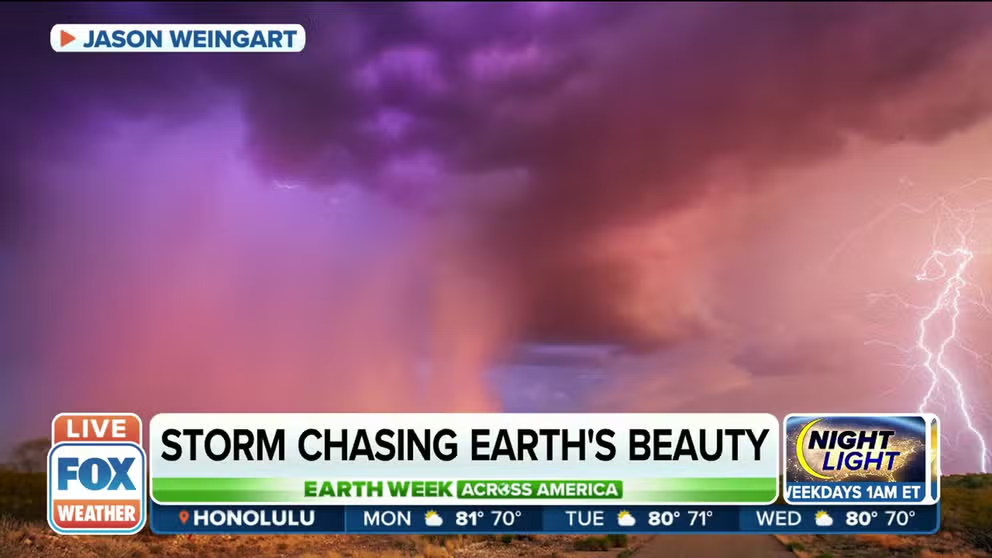In a flash: Lightning chaser shares how to capture nature's fury on camera
Lightning photographer Jason Weingart shares five essentials to getting that perfect lightning shot.
Storm Chaser offers "Storm Tours'
Storm Chaser Jason Weingart joins FOX Weather to discuss the dangers of storm chasers and how he gives 'Storm Tours' to weather enthusiasts.
AUSTIN, Tex. – Some 20 million lightning bolts strike the United States each year, and while lightning can be dangerous and is responsible for billions in damage each year, when viewed from a safe distance, it can be an electrifying display of natural beauty.
Photographer Jason Weingart uses that natural beauty to make stunning artwork, and now he's sharing some of his tips to getting that perfect shot.
Weingart travels the nation chasing storms, a passion that began with a fateful thunderstorm outside his Austin, Texas home. Weingart's career began as a sports photographer, but tiring of the repetitive nature of the business, he tried to get some lightning photos from his driveway as he's had an interest in weather since childhood.
"It took me a few tries, and then I finally got one, and I decided that's what I really liked," Weingart said. "And I just ran with that and quit doing all the studio stuff that we had to do… I was just done with it and just completely on nature weather."
THE 5-POINT SEVERE THUNDERSTORM RISK CATEGORY SCALE EXPLAINED
What you'll need to bring along
Weingart says there are some essentials to getting that perfect lightning shot: A tripod, a DSLR or other camera capable of shooting longer exposures, a radar app for your smartphone (we know of a pretty good one), a remote trigger such as an intervalometer or lightning trigger, and some rain protection for your camera.
And don't skimp on the tripod.
"Don't cheap out on that $50 tripod that everyone has - the little plastic one because it's absolutely going to get tossed by that wind," he says, noting winds around thunderstorms can suddenly gust to 30-70 mph. "I've broken lots of cameras on cheaper tripods.
HOW DO LIGHTNING RODS WORK TO PROTECT HOMES AND BUILDINGS?
Where does he find lightning?
Weingart has been studying weather for years now, so he is well versed in the forecast, but he says newer high-resolution short-term forecast models that update every hour like the HRRR model are pretty on point.
"It makes it pretty easy anymore to pick your target locations," he said.
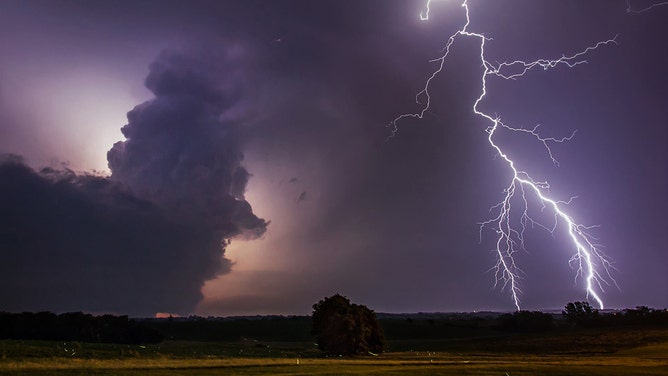
Positive cloud to ground lightning from a supercell over Weston, Missouri. June 29, 2014
(Jason Weingart)
Florida is the lightning capital of the U.S., while the desert monsoon season in the Southwest in the summer are popular places to find frequent lightning.
"Arizona was great for that kind of thing during summer because it's super predictable," he says. "You got just crazy terrain with the mountains and cactus and things like that." But he travels 50,000 miles a year chasing the storms from the Dakotas to the Gulf.
FALL IS THE SECOND SEVERE WEATHER SEASON
Once you're near your thunderstorm, look for a place on the outer edge of the storm where it's drier.
"You really don't want to be shooting from the core of the storm, where all the rain is," he says in his online lightning tutorial. "You most likely won't be able to keep your lens clean enough to get a good shot."
He says if you're under the anvil of the storm -- some of the best places for getting lightning, it could be raining at which point you'll want to be under an awning, use an umbrella, or even set up a tripod in your car.
He says he captured this dramatic lightning shot from a tripod on his passenger seat, as it was raining at the time:
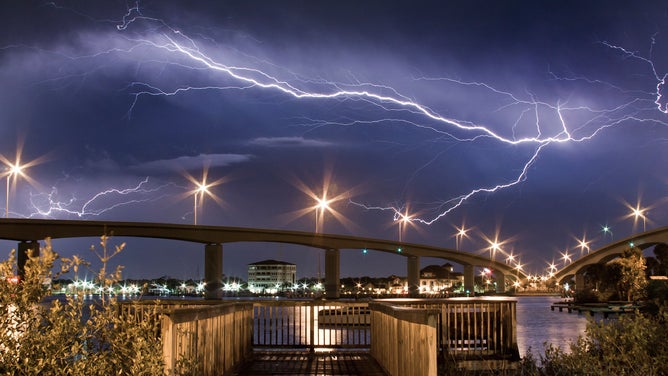
(Jason Weingart)
Another tip: Compose your shot to where it would look good even without the lightning so if you capture a lightning strike. "If you want your pictures to stand apart from everyone else's, find a compelling foreground, Weingart suggests. "There are millions of lightning photos out there. What can you do to make yours different?"
Always capture images in the RAW file setting -- don't use JPEG -- which will allow you to later recover more details in shadows, color balance and highlights, he says. Though those images are larger file sizes so be sure to have enough storage capacity.
WATCH VS. WARNING: HERE ARE THE DIFFERENCES BETWEEN THESE WEATHER TERMS THAT COULD SAVE YOUR LIFE
And take care not to overexpose your lightning shot -- a common mistake in lightning photography.
"You want to be sure your lightning isn't overexposed," he says. "But at the same time, you need to have some light in your foreground to add depth to the image."
How do I want to set my camera settings?
Weingart says there is no single magic camera setting to capture lightning as the best settings are dependent on several variables, such as distance to the storm and time of day.
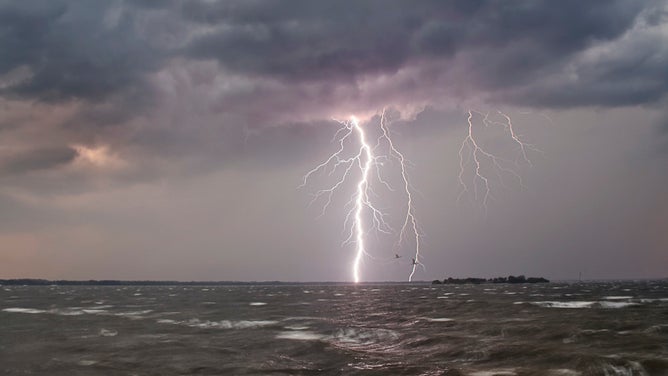
Lightning and a stepped leader over the Indian River in Titusville, Florida. June 14, 2011
(Jason Weingart)
Weingart has dozens of tips in his lightning tutorial but says there are three main categories of lightning photography: Daylight lightning, sunset/sunrise lightning and nocturnal lightning.
Nighttime lightning is the best for getting the most detailed lightning shot, but capturing bolts are sunrise or sunset can be the most colorful and dramatic.
But there are some tips common to all times of day:
- Use a tripod and an intervalometer to eliminate camera shake
- Turn off any image stabilization your lens may have
- Manually focus lens to infinity: "The best way to do this is by switching to the live view setting on the camera and zooming in on a distant light source in your LCD screen," he says. "Turn the focus ring until the light appears sharp."
For specific settings, he says it depends on such factors as how close is the lightning (if close, stop down the aperture and keep ISO relatively low to prevent light blowout), how fast clouds are moving (if moving fast with frequent lightning, use shorter exposure times to prevent "ghosting" of images), how much ambient light (bright lights in the foreground would require shorter exposures and lower ISO) and if making a time lapse, keep exposures short otherwise video will too short.
DEBUNKING 7 MYTHS ABOUT LIGHTNING
Take test exposures first to make sure your settings are good before you let the camera run for an extended time, and if you leave your camera in one spot and shoot at consistent intervals, not only can you get a great time lapse video, but you can combine several images into an "apocalyptic looking lightning stack."
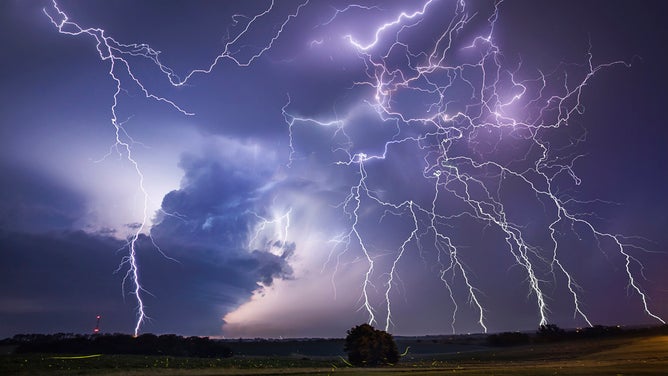
Stacked image of a positive lightning flash rate jump over Weston, Missouri. June 29, 2014
(Jason Weingert)
Safety first!
Lightning is an incredible sight, but it's also incredibly dangerous. Bolts can have anywhere from 100 million to 1 billion volts and can heat the surrounding air to as much as 50,000 degrees. So you need to keep yourself safe while shooting.
He suggests setting up a tripod and running 2-3 second exposures and then retreating to safety.
WHAT HAPPENS WHEN SOMEONE GETS STRUCK BY LIGHTNING
"Don't do anything stupid," Weingart says. "It's really easy to get caught up in the moment trying to get a picture and get yourself into a dangerous spot. So just be aware and have a plan to get yourself somewhere safe quick."
He suggests if the lightning is close and you're feeling nervous, set up your camera to run on its own and get back in your car or shelter.
"And when it's done, you know, real quick, run down, grab (the camera) and get back in and just limit the amount of time that you're exposed to lightning because, you know, it's just a numbers game," he said. "The longer you're out there standing around that kind of stuff, it just ups your chances of something negative happening."
His favorite shot
Weingart has now taken hundreds of lightning and other storm photos over his career and runs a successful photography workshop business and during severe weather season, runs storm chasing tours.
But of all the lightning photographs he's taken, one stands out he captured last summer in Big Bend National Park in Texas, and not just because of what was captured in the lens.
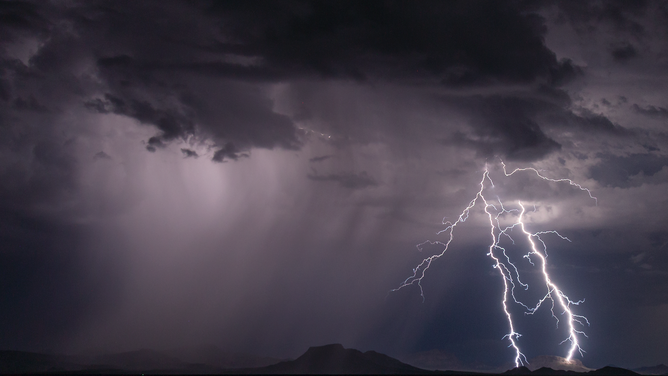
Lightning in Big Bend State Park, Texas
(Jason Weingart)
"I just got one (lightning photograph) this past summer and I had my whole family with me - my wife, my son and my daughter - and they were getting pictures of it too," he said. "I got one shot where you can actually see where the lightning hit. So that's probably my favorite now -- just the memory attached to it. They're all special in their own way but getting to share it with them is rare for me and that made it super cool."
